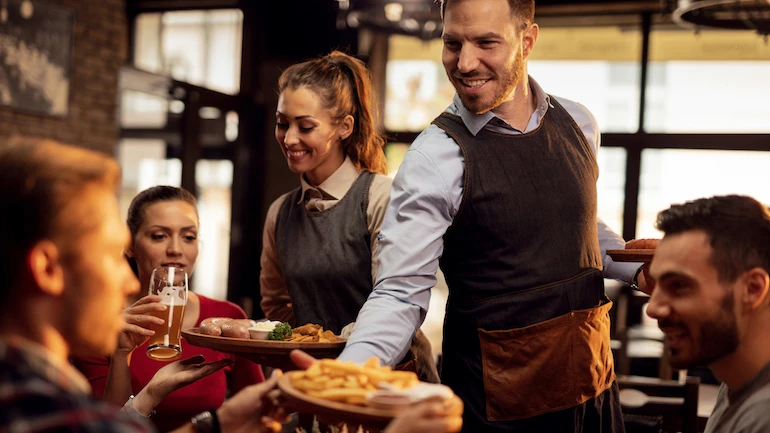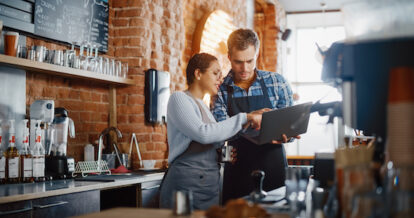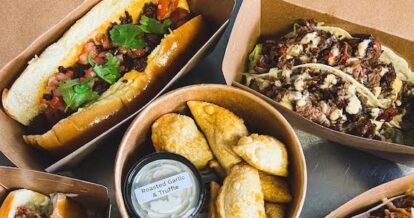You’ve worked hard to get your restaurant to where it is today – longevity is notoriously difficult to achieve in this industry! If you want to continue to stay in the game for years to come, it’s critical to set restaurant benchmarks. These metrics help you track your progress over time and chart a course toward your future goals.
Regularly measuring business performance is important for several reasons, but mainly to ensure that your restaurant is financially sound, and that your employees and customers are happy.
In this guide to small business benchmarks for restaurants, we’ll cover:
- What are restaurant benchmarks?
- How to measure overall performance
- How to measure front-of-house performance
- How to measure back-of-house performance
Grab your calculator, and let’s go.
What are Restaurant Benchmarks?
Restaurant benchmarks are key performance indicators (KPIs) that help you keep track of how your business is doing financially and operationally. Measuring and understanding these restaurant business KPIs enables you to make informed strategic decisions, so you can drive profitability and growth.
Running your restaurant with clear small business benchmarks in place helps you identify areas that may need more attention, such as staffing or inventory management. It also allows you to see where you’re already performing well.

Benchmarks to Measure Overall Performance
These 3 restaurant financial benchmarks are important indicators of the overall health of your business.
Prime Cost
Prime cost refers to the combined cost of your labor and cost of goods sold (CoGS). These are the expenses you must incur to produce the items on your menu and serve your guests. However, prime costs don’t include things like kitchen equipment.
Just like your spouse or partner’s birthday, your prime cost is a number you must know. Why? It can tell you the answer to a mission-critical question: Will your restaurant have enough money to keep the lights on if times get tough?
There are a few steps to calculating your prime cost:
- Calculate your CoGS using this formula: [Beginning Inventory of F&B] + [Purchases] – [Ending Inventory] = CoGS for the period
- Calculate your labor costs in two categories, salaried and hourly employees. Don’t forget about taxes, benefits, insurance, and workers’ compensation.
- Calculate your prime cost: [CoGS] + [Total Labor Cost] = Prime Cost
Any prime cost between 55-60% is considered good. Less than 50% could indicate you’re running too lean, and more than 70% means it’ll likely be hard for you to make a profit. Aim for that happy medium!
Profit Margin
Profit margin, or the amount of profit expressed as a percentage of your annual sales, is one of the top restaurant KPIs you need to know.
This metric tells you whether or not your business is profitable, and if so, to what extent. Your sales figures might be impressive, but if you’re spending all of the revenue your restaurant brings in (or worse, spending beyond your means), you may not be in business very long.
Profit also enables you to invest back into your restaurant. For example, if your dining room is overdue for an upgrade, having healthy profits means you’ll have the funds you need to cover these expenditures and improve your guest experience.
Here’s how you can calculate your profit margin:
- Subtract your CoGS from your total revenue
- Divide that figure by your total revenue
- Multiply that figure by 100 to get a percentage
Wondering how you compare to your peers? The average profit margin for a full service restaurant in the U.S. is 9.8%, according to TouchBistro’s 2025 State of Restaurants Report.
Sales Per Square Foot
Sales per square foot is another one of the most useful restaurant financial benchmarks for gaining insight into business performance.
It demonstrates how many sales you’re making out of your restaurant, per square foot, so you know how well you’re leveraging your available space. This can help you understand whether you have the right amount and configuration of tables in your dining room, for instance.
Calculating your sales per square foot is simple. Just divide your total in-house sales by the total interior square footage of your restaurant. Include your entire space, which means accounting for spaces like the kitchen and restrooms as well.
Wondering what sales per square foot benchmark you should aim for? “Sales levels of $250 to $325 per square foot (full-service) and $300 to $400 (limited-service), restaurants may see moderate profits,” according to award-winning fast casual restaurant Wayback Burgers.

Benchmarks to Measure Front-of-House Performance
While tracking your restaurant’s overall performance is essential, it’s also important to set benchmarks for your front of house and back of house staff.
These 4 restaurant KPIs give you insight into how well your front of house is running.
Revenue Per Seat Hour (RevPASH)
Revenue per seat hour refers to how much money your restaurant can expect to make, per seat, in a given period of time based on your available seat hours during that time frame. You may choose to measure your revPASH by the week, day, or even the shift – think lunch vs. dinner. The latter is a wise move because it will let you see how different shifts fare.
This metric shows you how well you’re managing a precious asset: time. As a result, it can help you make strategic business decisions.
“Periods with higher RevPASH indicate times when it’s probably in your best interest to turn tables…whereas when RevPASH is relatively low, upselling might be the best strategy for increasing revenue,” according to restaurantowner.com.
To calculate your revPASH for a particular time frame, divide your revenue in that period by the available seat hours in the same time frame. Here’s an example based on a dinner service from 5 to 10 p.m.: $5,000 in revenue / (50 seats x 5 hours x 1 day) = $20
The bottom line? The higher your revPASH, the better your restaurant is performing.
Table Turnover Rate
Table turnover rate indicates how long you can expect customers to stick around. Generally speaking, the more tables you can serve per day, the greater your sales will be – especially if your revPASH is high.
Knowledge is power, and being aware of how many times you’re turning over tables during service is key to increasing profitability.
There are a few steps to calculating your table turnover rate:
- Choose a period of time to measure, like Sunday brunch
- Count the number of parties (or covers) served at each table during this time period
- Divide the number of parties served by the number of tables
If you have 20 tables in your restaurant and you served 40 parties for Sunday brunch, your table turnover rate is 2. The industry average for a family restaurant is 3, so this tells you there’s an opportunity for you to speed up service and flip more tables.
Footfall
Knowing how many tables you’re turning over is a good start to optimizing business operations. Now, let’s find out how many customers you can expect to see walk through your doors during a given period of time. This metric is known as footfall, or foot traffic.
Footfall enables you to understand what times and days of the week your restaurant is busiest or slowest. It helps you plan for peak seasons like summer (hello, patio!) and the holidays, so you can staff up or down accordingly.
Calculating footfall involves the following steps:
- Count the total number of people entering your restaurant in a particular time period, such as a noon to 2 p.m. lunch rush on a Saturday
- Divide the number of people entering the store by the total amount of time
- Multiply by 24
Nowadays, technology like sensors and lasers can help you count footfall, and software can create reports that track your sales against the number of people who enter your restaurant. In an ideal world, every party that enters your restaurant would stick around for a meal or a drink. So, keep an eye on your footfall to ensure this is happening in most cases.
Staff Turnover Rate
This is the other kind of turnover you need to measure – except unlike your table turnover rate, lower is better when it comes to your staff turnover rate.
Measuring staff turnover tells you how often your employees are leaving your restaurant, which is something you want to minimize for financial reasons (recruitment and training are expensive!), as well as for the good of your culture and reputation.
Here are the steps to take to calculate your staff turnover rate:
- Choose a period of time to measure, like a month or a quarter
- Divide the number of employees who have left during that time frame by the number of employees it takes to fully staff your restaurant
- Multiply the resulting number by 100
Wondering how well you’re holding onto your team members? The average full service restaurant has a staff turnover rate of 26%, according to TouchBistro’s 2025 State of Restaurants Report.
Benchmarks to Measure Back-of-House Performance
After setting metrics for the front of house, it’s time to turn your attention to the kitchen. These 3 restaurant metrics reveal how well your business is functioning behind the scenes.
Food Cost Percentage
Food cost percentage refers to how much money you’re spending on food and beverage supplies. Considering that food is a major expense for any restaurant, it’s imperative to keep an eye on this number so it doesn’t break your bank account.
You can calculate your restaurant’s food cost percentage by dividing your total food costs by your total food sales in a given period of time, such as a month, quarter, or year. Then, multiply the resulting number by 100.
The average overall food and beverage cost percentage for a restaurant is between 20% and 40%. So, if you’re in that range, you can take a deep breath!
Menu Item Profitability
Menu item profitability is the profit margin you earn on each of your menu items. It’s important to measure so you know which menu items drive the highest profits, and which items are lagging at the back of the pack. This affects your restaurant’s overall profit margin.
To determine the profitability of a particular menu item, start with the menu price of the item, then subtract the cost of producing that item.
Not sure what kind of menu item profitability to aim for? Here’s a tip from DoorDash: “While most menu items are priced to generate a 35 to 40% gross profit margin, consider aiming higher when pricing your desserts. Desserts are often shared, adding little to your check averages, and could extend your turn times, resulting in higher costs than other items on the menu.”
Inventory Turnover Rate
This metric tracks how much time has passed from the day you purchase an item – think flour – to the day you run out of that item. In turn, it shows you the rate at which you need to replace your inventory. It’s critical to measure your inventory turnover rate so you can always make sure your restaurant is properly stocked with the right ingredients. Nobody wants to run out of chicken wings on game day!
You can calculate your inventory turnover rate by starting with your CoGS for a given period of time and dividing that number by your average inventory for the same time frame.
If you have a high inventory turnover rate, this signals strong sales. Congrats!
Go ahead, call yourself a business whiz. You now know the top 10 restaurant business KPIs to track so you can keep your restaurant running smoothly – and profitably – for years to come.
Download our free inventory template
Sign up for our free weekly TouchBistro Newsletter







